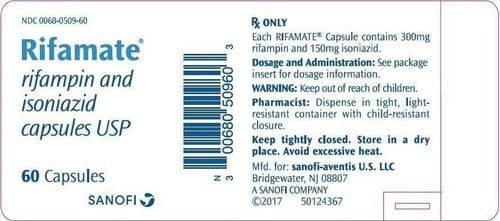This is an automatically translated article.
Sulbactam is an active ingredient often combined with penicillin group antibiotics to treat bacterial infections. So what is the use of Sulbactam and how to use this medicine?
1. What is the use of Sulbactam?
Sulbactam is a β-lactamase inhibitor, it is structurally similar to beta lactam but has very weak antibacterial activity. Therefore, it is not used alone in clinical practice.
When Sulbactam binds to beta lactamase, it inactivates this enzyme, thus protecting beta lactam antibiotics from degradation. Therefore, Sulbactam is used in combination with the penicillin group to expand the spectrum of action of these antibiotics with bacteria that secrete beta lactamse such as enterococci, E. coli, staphylococcus, Klebsiella, Branhamella, Proteus , Neisseria, anaerobic Bacteroides, Acinetobacter.
Sulbactam is combined with β-lactam antibiotics such as Ampicillin/Sulbactam:
Powder for oral suspension 250 mg/ml. Powder for injection (intramuscular or intravenous) with different strengths: 1.5g including ampicillin 1g and Sulbactam 0.5g; 3g includes ampicillin 2g and Sulbactam 1g; 15g includes ampicillin 10g and Sulbactam 5g. Currently, Sulbactam is available in combination products with ampicillin indicated for the treatment of infections caused by or suspected to be caused by beta-lactamase-producing bacteria, where ampicillin alone is not effective.
Sulbactam in combination with ampicillin is indicated in the following cases:
Treatment of upper and lower respiratory tract infections including: Sinusitis, otitis media, epiglottitis and bacterial pneumonia Urinary tract infections urethritis and nephritis - pyelonephritis. Intra-abdominal or gynecological disease suspected to be caused by anaerobic bacteria. Meningitis Infection of the skin, muscles, bones, joints. Uncomplicated gonorrhea. Sulbactam is contraindicated in the following cases:
People with hypersensitivity to Sulbactam or to any of its ingredients. Caution should be exercised in patients who are allergic to other beta-lactam antibiotics (eg, cephalosporins). Patients with a history of cholestatic jaundice or liver dysfunction associated with ampicillin Sulbactam.
2. Dosage and how to take Sulbactam
Dosage of Sulbactam is calculated according to the dose of ampicillin in combination with it. Specifically, the dosage of Sulbactam and Ampicillin should be according to the doctor's prescription, the reference dose is as follows:
Dosage of Sulbactam and Ampicillin for adults is as follows:
Intra-abdominal infection, gynecological infection or skin and skin structure: Use dose 1.5g (1g ampicillin + 0.5g Sulbactam) to 3g (2g ampicillin + 1g Sulbactam) IM/IV every 6 hours; The maximum dose is 12 g/day (i.e. 8 g ampicillin and 4 g sulbactam in the fixed combination). Acute pelvic inflammatory disease, orbital cellulitis: Use a dose of 3g (2g ampicillin/1g Sulbactam) every 6 hours with doxycycline. Discontinue intravenous injection 24 hours after clinical symptoms improve; Continue treatment with doxycycline orally (100 mg twice) for 14 days to complete treatment. Community-acquired pneumonia: Use doses of 1.5g (1g ampicillin + 0.5g Sulbactam) to 3g (2g ampicillin + 1g Sulbactam) by infusion every 6 hours for 5 days or more. Nosocomial pneumonia: Use a dose of 3g infusion every 6 hours for 5 days or more. Urinary tract infections, pyelonephritis: Use a dose of 3g (2g ampicillin + 1g Sulbactam) infusion every 6 hours for 14 days. Severe infections requiring hospitalization: Use doses of 1.5g (1g ampicillin + 0.5g Sulbactam) to 3g (2g ampicillin + 1g Sulbactam) by infusion every 6 hours for 5-7 days Penicillin-resistant intestinal infections or disease Patients sensitive to aminoglycosides: Use a dose of 3g (2g ampicillin + 1g Sulbactam) infusion every 6 hours for 6 weeks if not resistant to aminoglycosides; more than 6 weeks if aminoglycoside resistant. HACEK infection: Use 3g (2g ampicillin + 1g Sulbactam) by infusion every 6 hours for 4 weeks. Dosage of Sulbactam and Ampicillin for children:
Skin infections:
Children > 1 year old (<40kg): Use a dose of 200mg/kg/day infusion divided into 6 hours; the duration of treatment should not exceed 14 days. Children > 1 year old (>40kg): Use dose 1.5 g (1g ampicillin + 0.5g Sulbactam) to 3g (2g ampicillin + 1g Sulbactam) per day; Maximum dose is 12g/day. Epiglottitis: Use a dose of 100-200mg ampicillin/kg/day infusion divided every 6 hours.
Mild or moderate infections:
Children > 1 month - 1 year old: Use a dose of 100-150 mg ampicillin/kg/day, IM/IV divided every 6 hours. Children > 1 year: Use a dose of 100-200 mg ampicillin/kg/day, intramuscularly or intravenously divided every 6 hours. Meningitis or severe infection:
Children > 1 month - 1 year old: Use a dose of 200-300mg ampicillin/kg/day, intramuscularly or intravenously divided every 6 hours. Children > 1 year: Use a dose of 200-400 mg ampicillin/kg/day, intramuscularly or intravenously divided every 6 hours. Peritoneal and oropharyngeal abscess
Children and adolescents 200 mg ampicillin/kg/day intravenously divided into 6 hours.
Dosage of Sulbactam and Ampicillin for patients with renal failure:
CrCl 5-14 mL/min/1.73 m2: Use a dose of 1.5g (1g amoxicillin + 0.5g Sulbactam) to 3g (2g ampicillin + 1g Sulbactam) infusion every 24 hours. CrCl 15-29 mL/min/1.73 m2: Use a dose of 3g (2g ampicillin + 1g Sulbactam) as an infusion every 12 hours. CrCl ≥ 30 mL/min/1.73 m2: No dose adjustment required.
3. What are the side effects of Sulbactam?
Common side effects when using Sulbactam in combination with ampicillin include:
Local reactions: Pain at the sites of intramuscular or intravenous injection, thrombophlebitis. Diarrhea Nausea, vomiting Rash Increased Alanine aminotransferase, Aspartate aminotransferase increased Anemia, thrombocytopenia, eosinophilia Hyperbilirubinemia. Rare side effects when using Sulbactam in combination with ampicillin include:
Urticaria, Erythema multiforme, Anaphylaxis, neutropenia, decreased hemoglobin, and hematocrit. Less common side effects when using Sulbactam in combination with ampicillin include: Glossitis.
Side effects of unspecified frequency of Sulbactam with ampicillin include:
Hemolytic anemia Gastritis Pseudomembranous colitis Agranulocytosis Thrombocytopenia purpura Anaphylactic shock Convulsions Inflammation of the mouth, tongue change color. Cholestatic hepatitis, liver dysfunction, jaundice.
4. Sulbactam interactions with other drugs
Probenecid reduces the renal tubular excretion of ampicillin and sulbactam when used together, this effect increases and prolongs the antibiotic serum concentration, prolongs the half-life and increases the risk of drug toxicity. Sulbactam sodium is compatible with all types of intravenous solutions. Ampicillin is incompatible with aminoglycosides and should not be mixed in the same syringe or container. Both sulbactam sodium and ampicillin sodium for intramuscular or intravenous injection are less stable in dextrose or other carbohydrate-containing solutions, and therefore should not be mixed with blood products or protein hydrolysates. Sulbactam is an active ingredient that is often combined with penicillin group antibiotics to treat bacterial infections. To ensure effective treatment and avoid side effects, patients need to strictly follow the instructions of the doctor.
Follow Vinmec International General Hospital website to get more health, nutrition and beauty information to protect the health of yourself and your loved ones in your family.
Please dial HOTLINE for more information or register for an appointment HERE. Download MyVinmec app to make appointments faster and to manage your bookings easily.













